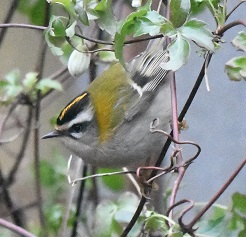Nature Notes February 2021
Date Published: 02-03-2021
The early part of the month was dominated by rain and wind, moving on to a calmer period of frosty nights and sunny days.
SIGHTINGS
Birds (seen or heard): Common Crows, Magpies, Buzzards, Sparrowhawk, Common Gulls, Black-headed Gulls, Green/Great Spotted Woodpeckers, Tawny Owls, Wood Pigeons, Stock Doves, Nuthatches, Treecreepers, Wrens, Female Blackcap, Blackbirds, Song Thrush, Robins, Firecrest, Dunnocks, Siskins, Goldfinches, Chaffinches, Bullfinches, Greenfinches, Coal/Blue/Great/Long-tailed Tits.
Insects: Midges, Buff-tailed Bees.
Mammals: Grey Squirrels, Foxes, Mole activity.
Plants: (in flower/berry) Common Gorse, Holly, Ivy, Cotoneaster.
Fungi: Turkey Tail, Birch Polypore.
Butterflies/Moths: Brimstone, Peacock, Red Admiral.
Pond Life: Whirlygig Beetles.
A quiet month to begin with, but the wildlife emerged in the last week with a change in the weather.
A Firecrest has been seen on several occasions.
The Sparrowhawks were seen hunting for prey along the Hazelwood boundary.
Early sightings of Brimstone, Peacock and Red Admiral Butterflies in the last week of the month.
Birds appeared to be paired, seeking nesting sites in the boxes provided on site.
NATURE FACT
At 9 cm the Firecrest is Britain’s smallest bird. It resembles the Goldcrest, but is identified by the bright white markings across the eye. A very small and hyperactive species that always seems to be on the move. Tit like, it will feed among branches and sometimes hovers to snatch food from the undersides of leaves. It feeds almost exclusively on insects and spiders and sometimes it eats small seeds. Insects include flies, beetles and small caterpillars.
Recorder: C. Wilcox





